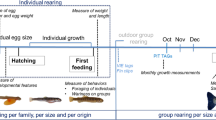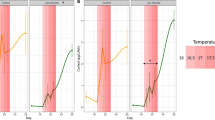Abstract
In fishes, elevated levels of cortisol in eggs can have carry-over effects on phenotypic and performance traits early in life. How responses to elevations in egg cortisol differ among species remains poorly understood. Using wild populations of chum salmon (Oncorhynchus keta) and sockeye salmon (O. nerka), we investigated whether experimentally-elevated concentrations of cortisol in newly fertilized eggs had effects on offspring morphology and/or burst swimming capacity. Immediately following fertilization, eggs were incubated for 2 h with water dosed with 0 ng/mL or 1000 ng/mL of cortisol. Embryos were reared to the fry life stage (complete yolk sac absorption). Morphology and burst swimming performance of fry were then assessed. Sockeye salmon fry reared from cortisol-treated eggs were smaller overall (i.e., smaller body, fins and eyes) compared to conspecifics reared from untreated eggs. In contrast, the morphology of chum salmon fry was not affected by the experimental elevation of egg cortisol. In both species, burst swimming duration was unaffected by egg cortisol treatment, while offspring reared from the cortisol-treated eggs initiated fewer bouts of burst swimming. Our results demonstrate that closely-related species can respond differently to elevations in egg cortisol, and not all offspring traits may be affected by these elevations in cortisol. Further efforts to establish links among offspring quality, maternal stress, and egg composition need to consider the potential for divergent responses among species and examine multiple measures of phenotype and performance throughout development.



Similar content being viewed by others
References
Andersson MÅ, Silva PIM, Steffensen JF, Höglund E (2011) Effects of maternal stress coping style on offspring characteristics in rainbow trout (Oncorhynchus mykiss). Horm Behav 60:699–705
Auperin B, Geslin M (2008) Plasma cortisol response to stress in juvenile rainbow trout is influenced by their life history during early development and by egg cortisol content. Gen Comp Endocrinol 158:234–239
Barton BA (2000) Salmonid fishes differ in their cortisol and glucose responses to handling and transport stress. N Am J Aquacult 62:12–18
Barton BA (2002) Stress in fishes: a diversity of responses with particular reference to changes in circulating corticosteroids. Integr Comp Biol 42:517–525
Beamish FWH (1978) In: Hoar WS, Randall DJ (eds) Swimming capacity. Fish Physiology, Vol VII Academic Press, New York, pp. 101–187
Birtwell IK, Nassichuk MD, Beune H (1987) Underyearling sockeye salmon (Oncorhynchus nerka) in the estuary of the Fraser River. Canadian Special Publication of Fisheries and Aquatic Sciences 9:a25–a35
Bradford MJ (1995) Comparative review of Pacific salmon survival rates. Can J Fish Aquat Sci 52:1327–1338
Brett JR (1964) The respiratory metabolism and swimming performance of young sockeye salmon. J Fish Res Board Can 21:1183–1226
Burgner RL (1991) Life history of sockeye salmon (Oncorhynchus nerka). In Groot C, Margolis L (eds). Pacific salmon life histories. UBC press. Vancouver:1–117
Burt JM, Hinch SG, Patterson DA (2012a) Parental identity influences progeny responses to incubation thermal stress in sockeye salmon Oncorhynchus nerka. J Fish Biol 80:444–462
Burt JM, Hinch SG, Patterson DA (2012b) Developmental temperature stress and parental identity shape offspring burst swimming performance in sockeye salmon (Oncorhynchus nerka). Ecol Freshw Fish 21:176–188
Burton T, Hoogenboom MO, Armstrong JD, Groothuis TGG, Metcalfe NB (2011) Egg hormones in a highly fecund vertebrate: do they influence offspring social structure in competitive conditions? Funct Ecol 25:1379–1388
Bury NR, Sturm A (2007) Evolution of the corticosteroid receptor signaling pathway in fish. Gen Comp Endocrinol 153:47–56
Campbell PM, Pottinger TG, Sumpter JP (1994) Preliminary evidence that chronic confinement stress reduces the quality of gametes produced by brown and rainbow trout. Aquaculture 120:151–169
Chadwick JG, Nislow KH, McCormick SD (2015) Thermal onset of cellular and endocrine stress responses correspond to ecological limits in brook trout, an iconic cold-water fish. Conserv Phys 3:cov017
Cook KV, McConnachie SH, Gilmour KM, Hinch SG, Cooke SJ (2011) Fitness and behavioral correlates of pre-stress and stress-induced plasma cortisol titers in pink salmon (Oncorhynchus gorbuscha) upon arrival at spawning grounds. Horm Behav 60:489–497
Crain CM, Kroeker K, Halpern BS (2008) Interactive and cumulative effects of multiple human stressors in marine systems. Ecol Lett 11:1304–1315
DFO (Fisheries and Oceans Canada) (2005) Canada’s policy for conservation of wild Pacific salmon. Available online - http://www.pac.dfo-mpo.gc.ca/publications/pdfs/wsp-eng.pdf (accessed 23/02/14)
Donaldson MR, Hinch SG, Raby GD, Patterson DA, Farrell AP, Cooke SJ (2012) Population-specific consequences of fisheries-related stressors on adult sockeye salmon. Physiol Biochem Zool 85:729–739
Donaldson MR, Hinch SG, Jeffries KM, Patterson DA, Cooke SJ, Farrell AP, Miller KM (2014) Species-and sex-specific responses and recovery of wild, mature Pacific salmon to an exhaustive exercise and air exposure stressor. Comp Biochem Phys A 173:7–16
Eriksen MS, Færevik G, Kittilsen S, McCormick MI, Damsgård B, Braithwaite VA, Braastad BO, Bakken M (2011) Stressed mothers–troubled offspring: a study of behavioural maternal effects in farmed Salmo salar. J Fish Biol 79:575–586
Essington TE, Quinn TP, Ewert VE (2000) Intra-and inter-specific competition and the reproductive success of sympatric Pacific salmon. Can J Fish Aquat Sci 57:205–213
Feist G, Schreck CB (2001) Ontogeny of the stress response in Chinook salmon, Oncorhynchus tshawytscha. Fish Physiol Biochem 25:31–40
Filby AL, Paull GC, Bartlett EJ, Van Look KJ, Tyler CR (2010) Physiological and health consequences of social status in zebrafish (Danio rerio). Physiol Behav 101:576–587
Hawkins DK, Quinn TP (1996) Critical swimming velocity and associated morphology of juvenile coastal cutthroat trout (Oncorhynchus clarki clarki), steelhead trout (Oncorhynchus mykiss), and their hybrids. Can J Fish Aquat Sci 53:1487–1496
Hoysak DJ, Liley NR (2001) Fertilization dynamics in sockeye salmon and a comparison of sperm from alternative male phenotypes. J Fish Biol 58:1286–1300
Hruska KA, Hinch SG, Healey MC, Patterson DA, Larsson S, Farrell AP (2010) Influences of sexual status and behavior on physiological changes among individual adult sockeye salmon during rapid senescence. Physiol Biol Chem 83:663–676
Hutchings JA, Reynolds JD (2004) Marine fish population collapses: consequences for recovery and extinction risk. Bioscience 54:297–309
Hwang PP, Wu SM, Lin JH, Wu LS (1992) Cortisol content of eggs and larvae of teleosts. Gen Comp Endocrinol 86:189–196
Jeffrey JD, Gilmour KM (2016) Programming of the hypothalamic-pituitary-interrenal axis by maternal social status in zebrafish (Danio rerio). J Exp Biol 219:1734–1743
Lema SC (2014) Hormones and phenotypic plasticity in an ecological contest: linking physiological mechanisms to evolutionary processes. Integr Comp Biol 54:850–863
Li M, Bureau DP, King WA, Leatherland JF (2010) The actions of in ovo cortisol on egg fertility, embryo development and the expression of growth-related genes in rainbow trout embryos, and the growth performance of juveniles. Mol Reprod Dev 77:922–931
Li M, Christie HL, Leatherland JF (2012) The in vitro metabolism of cortisol by ovarian follicles of rainbow trout (Oncorhynchus mykiss): comparison with ovulated oocytes and pre-hatch embryos. Reproduction 144:713–722
Marcalo A, Mateus L, Correia J, Fryer R, Stratoudakis Y (2006) Sardine (Sardina pilchardus) stress reactions to purse seine fishing. Mar Biol 149:1509–1518
McConnachie SH, Cook KV, Patterson DA, Gilmour KM, Hinch SG, Farrell AP, Cooke SJ (2012) Consequences of acute stress and cortisol manipulation on the physiology, behavior, and reproductive outcome of female Pacific salmon on spawning grounds. Horm Behav 62:67–76
McCormick MI (2009) Indirect effects of heterospecific interactions on progeny size through maternal stress. Oikos 118:744–752
Moore MC, Johnston GIH (2008) Toward a dynamic model of deposition and utilization of yolk steroids. Integr Comp Biol 48:411–418
Neff BD (2004) Increased performance of offspring sired by parasitic males in bluegill sunfish. Behav Ecol 15:327–331
Nesan D, Vijayan MM (2012) Embryo exposure to elevated cortisol level leads to cardiac performance dysfunction in zebrafish. Mol Cell Endocrinol 363:85–91
Nesan D, Vijayan MM (2016) Maternal cortisol mediates hypothalamus-pituitary-interrenal axis development in zebrafish. Sci Reports 6:22582
Paitz RT, Bukhari SA, Bell AM (2016) Stickleback embryos use ATP-binding cassette transporters as a buffer against exposure to maternally derived cortisol. P Roy Soc B-Biol Sci 283:20152838
Pikulkaew S, Benato F, Celeghin A, Zucal C, Skobo T, Colombo L, Dalla Valle L (2011) The knockdown of maternal glucocorticoid receptor mRNA alters embryo development in zebrafish. Dev Dynam 240:874–889
Pon LB, Hinch SG, Wagner GN, Lotto AG, Cooke SJ (2007) Swimming performance and morphology of juvenile sockeye salmon, Oncorhynchus nerka: comparison of inlet and outlet fry populations. Environ Biol Fish 78:257–269
Pottinger TG (2010) A multivariate comparison of the stress response in three salmonid and three cyprinid species: evidence for inter-family differences. J Fish Biol 76:601–621
Pratap HB, Wendelaar Bonga SE (1990) Effects of water-borne cadmium on plasma cortisol and glucose in the cichlid fish Oreochromis mossambicus. Comp Biochem Phys C 95:313–317
Quinn TP (1999) Variation in Pacific salmon reproductive behaviour associated with species, sex and levels of competition. Behaviour 136:179–204
Salo EO (1991) Life history of chum salmon (Oncorhynchus keta). In Groot C, Margolis L (eds). Pacific salmon life histories. UBC press. Vancouver:213–310
Sheriff MJ, Love OP (2013) Determining the adaptive potential of maternal stress. Ecol Lett 16:271–280
Sloman KA (2010) Exposure of ova to cortisol pre-fertilisation affects subsequent behaviour and physiology of brown trout. Horm Behav 58:433–439
Sopinka NM, Hinch SG, Lotto AG, Whitney CK, Patterson DA (2013) Does among-population variation in burst swim performance of sockeye salmon Oncorhynchus nerka fry reflect early life migrations? J Fish Biol 83:1416–1424
Sopinka NM, Hinch SG, Middleton CT, Hills JA, Patterson DA (2014) Mother knows best, even when stressed? Effects of maternal exposure to a stressor on offspring performance at different life stages in a wild semelparous fish. Oecologia 175:493–500
Sopinka NM, Hinch SG, Healy SJ, Harrison PM, Patterson DA (2015) Egg cortisol treatment affects the behavioural response of coho salmon to a conspecific intruder and threat of predation. Anim Behav 104:115–122
Stouthart AJ, Lucassen EC, Van Strien FJ, Balm PH, Lock RA, Wendelaar Bonga S (1998) Stress responsiveness of the pituitary-interrenal axis during early life stages of common carp (Cyprinus carpio). J Endocrinol 157:127–137
Stratholt ML, Donaldson EM, Liley NR (1997) Stress induced elevation of plasma cortisol in adult female coho salmon (Oncorhynchus kisutch), is reflected in egg cortisol content, but does not appear to affect early development. Aquaculture 158:141–153
Taylor EB, McPhail JD (1985) Burst swimming and size-related predation of newly emerged coho salmon Oncorhynchus kisutch. T Am Fish Soc 114:546–551
Tierney KB, Patterson DA, Kennedy CJ (2009) The influence of maternal condition on offspring performance in sockeye salmon Oncorhynchus nerka. J Fish Biol 75:1244–1257
Warner DA, Radder RS, Shine R (2009) Corticosterone exposure during embryonic development affects offspring growth and sex ratios in opposing directions in two lizard species with environmental sex determination. Physiol Biochem Zool 82:363–371
Acknowledgments
Research conformed to protocols approved by UBC’s Committee on Animal Care (#A11 0215) and met the Canadian Council on Animal Care guidelines. We thank members of UBC’s Pacific Salmon Ecology and Conservation Lab, DFO Environmental Watch, DFO Stock Assessment, J. Burke and undergraduate volunteers for fish collection and offspring rearing, J. Hills and A. Faure for egg cortisol extraction, and anonymous reviewers for constructive feedback on earlier versions of this manuscript. SGH is funded by a Natural Sciences and Engineering Research Council of Canada (NSERC) Discovery, Strategic and Network (Ocean Tracking Network Canada) grant. NMS and GDR were funded by NSERC graduate scholarships, and SJH was funded by an NSERC undergraduate student research award (USRA).
Author information
Authors and Affiliations
Corresponding author
Rights and permissions
About this article
Cite this article
Sopinka, N.M., Hinch, S.G., Healy, S.J. et al. Effects of experimentally elevated egg cortisol on offspring traits in two species of wild Pacific salmon. Environ Biol Fish 99, 717–728 (2016). https://doi.org/10.1007/s10641-016-0513-x
Received:
Accepted:
Published:
Issue Date:
DOI: https://doi.org/10.1007/s10641-016-0513-x




